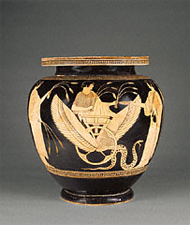 |
 |
 |
Grades/Level: Lower Elementary (K–2), Upper Elementary (3–5), Middle School (6–8), High School (9–12), Adult Learners
Subjects: Visual Arts, English–Language Arts
Time Required: Short Activity
20 minutes
Author: J. Paul Getty Museum Education Staff
|
 |
 |
 |
 |
 |
Activity Overview |
Students are taught how to see and learn more about works of art from close observation. |
 |
 |
 |
Learning Objectives |
Students should be able to:
• Articulate why more than 30 seconds is required to look at a work of art in order to gain an understanding of it.
• Give reasons why discussing a work of art with others increases their understanding of it. |
 |
 |
 |
 |
 |
Materials |
• A poster or image of any work of art, we suggest one of the following: |
 |
 |
 |
|
|
 |
 |
Activity Steps |
Step 1: Before displaying the poster, ask students to estimate how long they think the average museum visitor spends looking at a work of art. Students may ask for clarification and say it depends, but ask them to make a guess. One minute? 10 minutes? An hour? What do they think? Record their responses and tell them that museum studies have determined that the average viewer spends about 30 seconds looking at a work of art.
Step 2: Tell your class that they will have only 30 seconds to look at a poster of an object. (You may use any work of art.) Give them 30 seconds to look at it. You may need to divide them into groups so that they will be able to get close to the image. After 30 seconds are up have the students turn their backs to the poster.
Step 3: While students have their backs to the work of art, go around the room and ask each student to name one thing they saw in the picture. Ask students not to repeat answers. If necessary, prompt your students with questions: Did you see any people in the picture? Is the scene tidy or chaotic? Did anyone see animals? What kind of action did you see? Then ask students to describe the one aspect of the work that they remember most vividly. Does everyone have the same recollection? Comment on the variety of responses. Did they all look at the same artwork?!
Step 4: Ask your students, if they had more time and took a second look, do they think they would see more? Have the students turn around and look at the poster again. Do they see anything new or something that was not mentioned before? Guide the students through a careful re-examination. How much longer did they spend looking at the poster the second time? Was their first glance sufficient? Ask students if discussing their observations with their peers helped them see and understand the work of art better. Why or why not?
Now try this with a real work of art
in the Villa galleries!
|
 |
 |
 |
| Mixing Vessel with Triptolemos, Attributed to the Syleus Painter, Greek, 470 B.C. |
 |
|
 |



